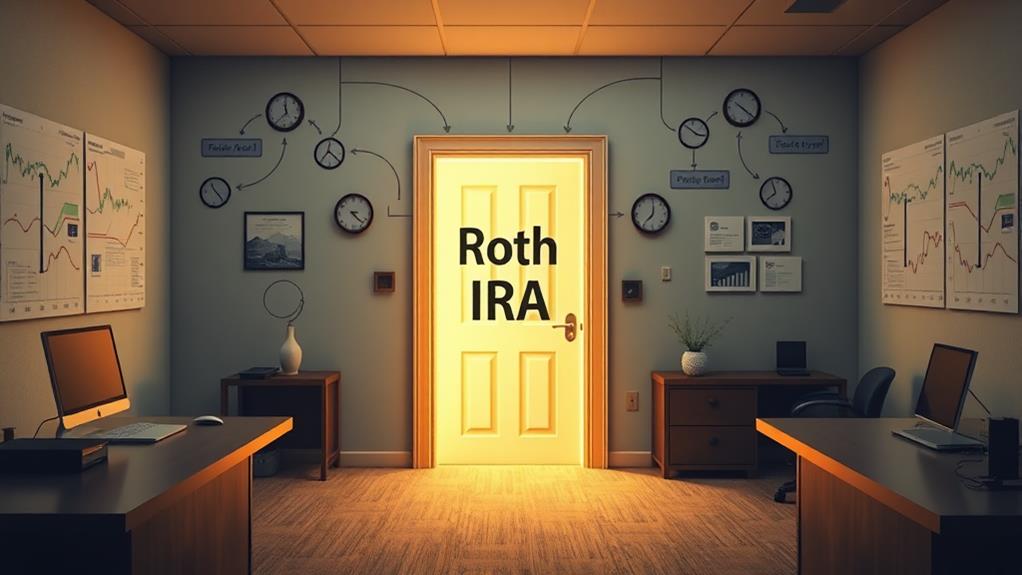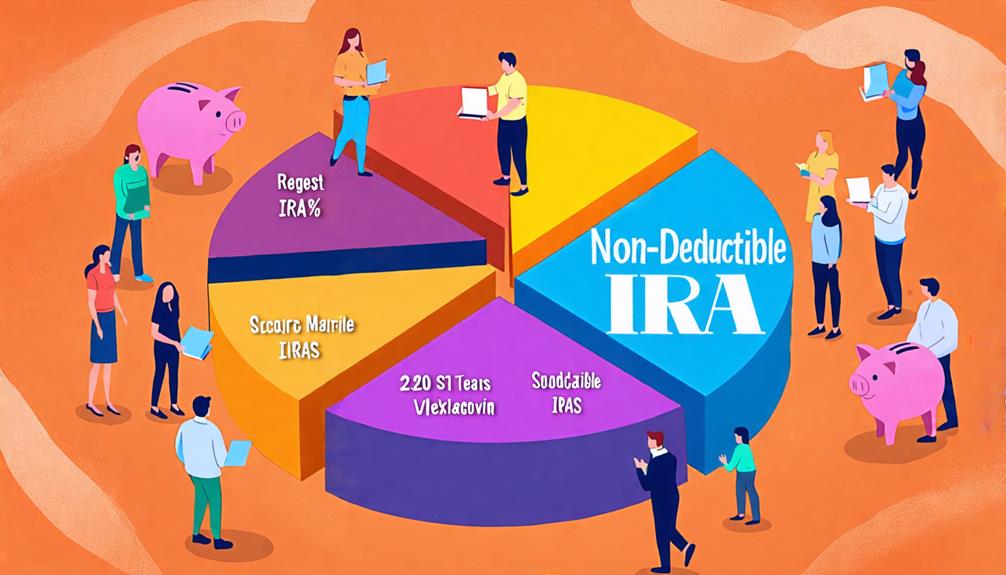A Non-Deductible IRA is a type of individual retirement account that uses after-tax contributions, offering tax-deferred growth on investments. While contributions are not tax-deductible, this account is valuable for high-income earners who exceed traditional IRA income limits. It allows for strategic moves like backdoor Roth conversions, providing potential tax-free withdrawals in retirement. Accurate tracking of contributions and annual Form 8606 filing with the IRS is essential to prevent double taxation. Understanding the specific income thresholds and compliance requirements helps maximize this retirement savings strategy. To explore the nuances and benefits, continue to uncover detailed insights.
Key Takeaways
- Non-deductible IRAs are funded with after-tax dollars and offer tax-deferred growth on investments.
- High-income earners can use non-deductible IRAs for a backdoor Roth conversion strategy to bypass income limits.
- Accurate tracking of contributions and filing Form 8606 annually is crucial to avoid double taxation.
- Withdrawals involve both after-tax contributions and tax-deferred earnings, impacting tax-free and taxable portions.
- Consulting a financial advisor is recommended to maximize benefits and ensure compliance with IRS regulations.
What Is a Non-Deductible IRA?

A non-deductible IRA is an individual retirement account funded with after-tax dollars, distinguishing it from traditional IRAs where contributions are typically tax-deductible. This type of IRA is particularly useful for individuals who have surpassed the income thresholds that the IRS sets for deducting traditional IRA contributions.
While contributions to a non-deductible IRA do not reduce your taxable income in the year they are made, the account offers the advantage of tax-deferred growth on dividends and capital gains until funds are withdrawn.
Eligibility for a non-deductible IRA is influenced by factors such as income, tax filing status, and participation in other retirement plans. The IRS imposes specific income limits that determine whether your contributions to a traditional IRA are deductible, directing higher earners towards non-deductible IRAs.
For those who earn too much to contribute directly to a Roth IRA, a non-deductible IRA can serve as a vehicle for a backdoor Roth conversion strategy.
It is imperative to accurately track contributions to avoid tax issues. Each year, you must file Form 8606 to report your after-tax contributions, ensuring you do not pay taxes twice on the same funds when you eventually make withdrawals.
Benefits of Non-Deductible IRAs
Understanding the benefits of non-deductible IRAs begins with recognizing their distinct tax advantages. These accounts offer a tax-favorable way to save for retirement, allowing dividends and capital gains to grow without immediate taxation. This means that while contributions are made with post-tax dollars, the investment earnings within the account accumulate without being subject to yearly taxes, providing a significant growth potential over time.
One of the most compelling advantages is the potential for tax-free withdrawals during retirement. Because contributions are made with post-tax dollars, a portion of the withdrawals may not be taxed, which can offer a strategic edge in retirement planning. This feature is particularly beneficial for high-income earners who surpass the income limits for Roth IRAs, providing them with a feasible alternative to continue tax-advantaged savings.
Additionally, non-deductible IRAs require careful tracking of contributions and the annual filing of Form 8606 to ensure compliance and maximize tax advantages. Proper management of these contributions is crucial to avoid tax complications and to fully capitalize on the benefits offered by non-deductible IRAs.
Eligibility Requirements

Eligibility requirements for non-deductible IRAs frequently hinge on specific income thresholds and the presence of existing retirement plans. For single individuals, eligibility is determined by their modified adjusted gross income (MAGI). If a single taxpayer's income exceeds certain IRS-set limits, the ability to contribute to a nondeductible IRA may be reduced or phased out entirely.
Married couples face similar stipulations, but their eligibility also accounts for the combined household income and each spouse's participation in any workplace retirement plans.
The IRS annually establishes income limits that dictate these eligibility criteria, confirming that they are current and reflective of economic conditions. As income levels rise, so do the phase-out ranges, gradually reducing the amount that can be contributed to a nondeductible IRA.
This phased approach is designed to balance the benefits of tax-advantaged retirement savings with income equity considerations.
Understanding these eligibility requirements is crucial for individuals and couples aiming to maximize their retirement savings while adhering to IRS regulations. By staying informed about the specific income limits and phase-out ranges, you can make more strategic decisions regarding your retirement planning and guarantee compliance with tax laws.
Income Thresholds
Income thresholds are an essential factor in determining whether an individual or couple can contribute to a nondeductible IRA. These thresholds are mainly influenced by the modified adjusted gross income (MAGI) of the individual or household, as set annually by the IRS. Understanding these income benchmarks guarantees that you remain compliant and optimize your retirement planning.
For single individuals, the IRS specifies distinct income ranges that dictate eligibility for nondeductible IRA contributions. These limits are vital for determining the phase-out of deductions.
For married couples, the combined income levels and the presence of other retirement plans, such as a 401(k), impact their eligibility to a great extent. The IRS sets annual income limits which are crucial to be aware of for strategic financial planning.
To simplify, consider these key points:
- Single Individuals: Check the annual MAGI limits as prescribed by the IRS to know your eligibility.
- Married Couples: Your combined income and existing retirement plans determine if you can contribute to a nondeductible IRA.
- Deduction Phase-out: Be aware of the specific income thresholds that lead to a gradual phase-out of deductions.
Backdoor Roth Conversions

Backdoor Roth conversions have emerged as a strategic maneuver for high-income earners seeking to bypass the income limits imposed on direct Roth IRA contributions. This technique involves initially placing funds into a nondeductible IRA and subsequently converting these funds into a Roth IRA. By leveraging this strategy, individuals whose income exceeds the thresholds for direct Roth IRA contributions can still benefit from the Roth IRA's tax-free growth and withdrawal advantages.
Key to executing a backdoor Roth conversion is understanding that taxes may apply during the conversion process, particularly if there are existing pre-tax funds in traditional IRAs. In such cases, the pro-rata rule may come into play, potentially complicating the tax scenario. Careful planning and precise tracking of contributions are imperative to avoid unintended tax consequences.
Engaging with financial advisors is highly recommended to navigate the intricacies of backdoor Roth conversions. Advisors can offer tailored guidance based on individual financial situations and help ensure compliance with IRS regulations. For those determined to maintain control over their financial future, mastering the backdoor Roth conversion process can bring about significant long-term retirement benefits.
Tax Implications
Understanding the tax implications of nondeductible IRAs is essential for effective retirement planning. Properly tracking contributions with IRS Form 8606 guarantees accurate reporting and avoids potential tax issues.
Additionally, knowing how withdrawals and backdoor Roth conversions are taxed can help maximize the benefits of your retirement savings strategy.
Contribution Tracking Importance
Accurate tracking of nondeductible IRA contributions is a cornerstone of effective retirement planning, as it plays a pivotal role in minimizing unnecessary tax burdens. Ensuring meticulous record-keeping of these contributions is vital for several reasons.
Primarily, it helps you avoid double taxation on distributions in retirement. To achieve this, it is essential to file Form 8606 annually. This form reports after-tax contributions to your IRA, safeguarding your finances from potential overpayment of taxes.
Here are three key points to keep in mind:
- Annual Reporting: Filing Form 8606 each year is mandatory to document after-tax contributions, ensuring that the IRS recognizes these amounts and prevents double taxation.
- Clear Record Maintenance: Keeping detailed records of nondeductible contributions separate from deductible ones can prevent future tax complications, providing clarity and precision in your financial management.
- Tax Optimization: Properly managing and documenting your nondeductible IRA contributions can significantly enhance your tax situation in retirement, helping you retain more of your hard-earned money.
Withdrawal Tax Considerations
Securing detailed contribution tracking not only aids in preventing double taxation but also sets the stage for understanding the tax implications of withdrawals from a nondeductible IRA. Withdrawals from a nondeductible IRA involve both after-tax contributions and earnings. While the contributions themselves, being after-tax, are not subject to additional taxation upon withdrawal, the earnings and growth accrued within the IRA are tax-deferred until they are withdrawn.
When calculating the tax liability on a withdrawal, it is crucial to determine the proportion of after-tax contributions relative to the total IRA balance. This proportion dictates the tax-free portion of the withdrawal. Proper tracking of these after-tax contributions is essential to avoid overpaying taxes.
For example, if after-tax contributions constitute 30% of the IRA balance, then 30% of each withdrawal is tax-free, while the remaining 70% is taxable as ordinary income.
Understanding these nuances guarantees you maintain control over your financial planning. Accurate record-keeping and strategic withdrawal planning can significantly reduce unnecessary tax burdens, preserving more of your hard-earned savings for future use.
Backdoor Roth Conversion
In an effort to bypass income limitations that restrict direct contributions to a Roth IRA, many investors turn to the strategy known as the backdoor Roth conversion. This involves moving funds from a nondeductible IRA to a Roth IRA, allowing high-income individuals to benefit from the tax advantages of a Roth IRA.
The tax implications of a backdoor Roth conversion can be complex, largely influenced by the presence of pretax contributions and earnings within the nondeductible IRA. Converting from a nondeductible IRA to a Roth IRA may render a portion of the conversion taxable, particularly when pretax contributions are involved. Here are three key considerations:
- Taxable Amount: The taxable portion of the conversion is determined by the ratio of pretax contributions and earnings to the total IRA balance.
- Pro-Rata Rule: The IRS applies the pro-rata rule, meaning all IRA funds are considered when calculating the taxable amount, not just the converted amount.
- Record Keeping: Accurate records of all contributions and conversions are vital to properly report taxes and avoid potential penalties.
Consulting with a financial advisor or tax professional is essential to fully understand the tax consequences and ensure compliance. By staying informed and diligent, investors can effectively manage the tax implications of a backdoor Roth conversion.
Tracking Contributions

Properly tracking contributions to a nondeductible IRA is important for maintaining tax efficiency in retirement. Accurate record-keeping guarantees that you avoid overpaying taxes on distributions when you start withdrawing funds. By maintaining detailed records of all contributions, you can accurately report your taxes and avoid unnecessary financial pitfalls.
To achieve this, it is essential to use IRS Form 8606. This form is specifically designed to report nondeductible contributions and monitor their tax consequences. Consistently completing and submitting Form 8606 allows for precise accounting of your nondeductible IRA contributions, ensuring you are taxed correctly when distributions begin.
Furthermore, it is crucial to keep nondeductible and deductible contributions distinctly separate. Mixing these can lead to tax complications, resulting in potential overpayment or penalties.
Risks to Consider
When contributing to a nondeductible IRA, it's essential to meticulously track contributions to prevent tax complications. Failure to distinguish between nondeductible and deductible contributions can result in increased tax liabilities during retirement.
Additionally, filing Form 8606 annually is necessary to accurately report after-tax contributions and avoid future tax issues.
Tax Complications Potential
Traveling through the tax terrain of nondeductible IRAs can be fraught with complications, particularly if deductible and nondeductible contributions are not meticulously separated. One of the most significant risks involves the potential for higher taxes upon withdrawal. If you fail to distinguish between these two types of contributions accurately, you may face an unexpected tax burden during retirement. To navigate these complexities, it is imperative to maintain detailed records and file the necessary documentation, such as Form 8606, annually.
Consider the following key points to manage tax complications effectively:
- Higher Taxes Upon Withdrawal: Inaccurate separation of deductible and nondeductible contributions can lead to paying more taxes than necessary when you start withdrawing funds.
- Mandatory Form 8606 Filing: This form must be filed annually to report after-tax contributions, ensuring that the IRS acknowledges the nondeductible portion of your IRA, which can protect you from double taxation.
- Impact of Tax Brackets: The tax implications of your retirement distributions will vary based on your tax bracket at that time, making it essential to plan and understand your future tax situation.
Exploring alternative investment options, such as taxable accounts with tax loss harvesting, could also help mitigate potential tax complications.
Contribution Tracking Necessity
Accurate tracking of nondeductible IRA contributions is crucial to avoiding future tax pitfalls. Keeping meticulous records of these contributions ensures you do not inadvertently pay taxes twice on the same funds. To achieve this, filing IRS Form 8606 annually is necessary for reporting after-tax contributions to your IRA accurately. Neglecting this step can lead to significant tax complications when you begin taking distributions during retirement.
Failure to distinguish between nondeductible and deductible contributions can create confusion and potential financial losses. Without clear separation, you risk inflating your taxable income upon withdrawal, thereby diminishing the tax advantages that nondeductible IRAs offer.
By maintaining detailed records and understanding the tax implications, you enable yourself to make informed decisions about your retirement savings strategy.
Tracking contributions meticulously is not merely a regulatory requirement but a strategic measure to maximize the tax benefits of your nondeductible IRA. A well-documented history of your contributions provides clarity and control, allowing you to accurately calculate the taxable and non-taxable portions of your IRA distributions.
Retirement Planning Tips

Achieving a secure and comfortable retirement demands careful planning and informed decision-making. By taking strategic steps, you can guarantee your financial future aligns with your aspirations. Here are key tips for effective retirement planning:
- Set Clear Savings Goals: Determine your retirement savings goals based on your desired lifestyle and expected expenses during retirement. This involves calculating how much you need to save to maintain your standard of living and accounting for healthcare, travel, and other personal interests.
- Maximize Employer Contributions: Take full advantage of any 401(k) matching contributions offered by your employer. This is basically free money that can greatly boost your retirement savings. Make sure you are contributing enough to your 401(k) to receive the maximum match available.
- Consult Financial Advisors: Engage with a financial advisor to align your retirement goals with appropriate investment strategies. A professional can help you evaluate the long-term implications of contributing to a non-deductible IRA and balance your portfolio to optimize returns while managing risks.
Considering the various retirement savings options, including non-deductible IRAs, is vital. Understanding the risks and benefits allows for informed decisions that maximize financial security in retirement. By implementing these tips, you maintain control over your retirement planning, ensuring a financially stable future.
Frequently Asked Questions
How Do Non-Deductible IRAS Compare to Other Types of Retirement Accounts?
Non-deductible IRAs, funded with after-tax dollars, offer tax-deferred growth and partially tax-free withdrawals, contrasting with traditional IRAs' deductible contributions and Roth IRAs' tax-free distributions. High-income earners benefit from backdoor Roth conversions for enhanced tax efficiency.
What Happens to Non-Deductible IRA Contributions After Retirement?
Upon retirement, non-deductible IRA contributions, made with after-tax dollars, remain non-taxable upon withdrawal. However, the earnings accrued on these contributions are subject to income tax, necessitating meticulous record-keeping to differentiate between taxable and non-taxable portions.
Can Non-Deductible IRA Funds Be Inherited by Beneficiaries?
Yes, non-deductible IRA funds can be inherited by beneficiaries. Beneficiaries must adhere to IRS rules for distributions and understand tax implications. Consulting a financial advisor or tax professional is advised to effectively manage inherited non-deductible IRA funds.
Are There Any Penalties for Early Withdrawals From Non-Deductible Iras?
Early withdrawals from non-deductible IRAs before age 59½ generally incur a 10% penalty on earnings unless exceptions apply, such as disability or first-time home purchases. Additionally, earnings are subject to income tax upon withdrawal.
How Do Non-Deductible IRAS Impact Required Minimum Distributions (Rmds)?
Non-deductible IRAs require adherence to RMD rules starting at age 72, calculated based on the account balance and life expectancy. Failure to comply results in steep tax penalties, with RMD amounts treated as taxable income annually.
Conclusion
Understanding non-deductible IRAs is essential for effective retirement planning. These accounts offer unique benefits, including potential tax-deferred growth and the opportunity for backdoor Roth conversions. Adhering to eligibility requirements and income thresholds is necessary to maximize their advantages. Additionally, awareness of tax implications and diligent tracking of contributions can mitigate potential risks. By incorporating non-deductible IRAs into a broader retirement strategy, individuals can enhance their financial stability and preparedness for the future.

